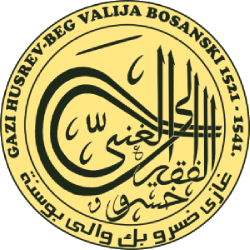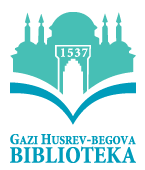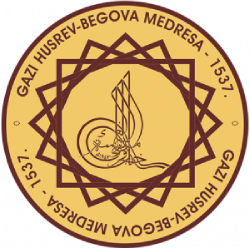
Sultanzade Gazi Husrev-beg was an Ottoman Bosnian sanjak-bey (governor) of the Sanjak of Bosnia in 1521–1525, 1526–1534, and 1536–1541. He was known for his successful conquests and campaigns to further Ottoman expansion into Croatia and Hungary. However, his most important legacy was major contribution to the improvement of the structural development of Sarajevo and its urban area. He ordered and financed construction of many important buildings there, and with his will bequeathed all his wealth into endowment for the construction and long-term support of religious and educational facilities and institutions, such as the Gazi Husrev-beg Mosque, and the Gazi Husrev-begova Medresa complex with a Gazi Husrev-beg Library, also known as Kuršumlija.

Gazi Husrev-beg Mosque is a mosque in the city of Sarajevo, Bosnia and Herzegovina. Built in the 16th century, it is the largest historical mosque in Bosnia and Herzegovina and one of the most representative Ottoman structures in the Balkans. Having been Sarajevo's central mosque since the days of its construction, today it also serves as the main congregational mosque of the Muslims in Bosnia and Herzegovina. It is located in the Baščaršija neighborhood in the Stari Grad municipality and, being one of the main architectural monuments in the town, is regularly visited by tourists.

Türbe refers to a Muslim mausoleum, tomb or grave often in the Turkish-speaking areas and for the mausolea of Ottoman sultans, nobles and notables. A typical türbe is located in the grounds of a mosque or complex, often endowed by the deceased. However, some are more closely integrated into surrounding buildings.

Baščaršija is Sarajevo's old bazaar and the historical and cultural center of the city. Baščaršija was built in the 15th century when Isa-Beg Ishaković founded the city.

Dr. Safvet-beg Bašagić, also known as Mirza Safvet, was a Bosnian writer who is often described by Bosniak historians as the "father of Bosnian Renaissance", and one of the most renowned poets of Bosnia and Herzegovina at the turn of the 20th century. Bašagić co-founded the political journal Behar and was a founder of the cultural society and magazine Gajret, and was elected President of the Bosnian council in 1910. He is also well known for his oeuvre which exceeds seven hundred biographies he compiled over decades.

The University of Sarajevo is a public university located in Sarajevo, Bosnia and Herzegovina. It is the largest and oldest university in the country, tracing its initial origins to 1537 as an Islamic madrasa.

Sanjak of Bosnia was one of the sanjaks of the Ottoman Empire established in 1463 when the lands conquered from the Bosnian Kingdom were transformed into a sanjak and Isa-Beg Isaković was appointed its first sanjakbey. In the period between 1463 and 1580 it was part of the Rumelia Eyalet. After the Bosnia Eyalet was established in 1580 the Bosnian Sanjak became its central province. Between 1864 and the Austro-Hungarian occupation of Bosnia in 1878 it was part of the Bosnia Vilayet that succeeded the Eyalet of Bosnia following administrative reforms in 1864 known as the "Vilayet Law". Although Bosnia Vilayet was officially still part of the Ottoman Empire until 1908 the Bosnian Sanjak de facto ceased to exist in 1878; when it was occupied by Austria-Hungary.

Morića Han is a han originally built in 1551 in Sarajevo, Ottoman Empire. After a fire in 1697 it was reconstructed in its current form. Morića Han is one of the buildings which were financed by and belonged to Gazi Husrev-Beg's endowment (Vakuf). It is the only surviving han in Sarajevo. It is located in Baščaršija, Sarači street, in Stari Grad.
Murat Bey Tardić or Murat-beg Tardić was an Ottoman general.
The following is a timeline of the history of the city of Sarajevo, Bosnia and Herzegovina.

The Gazi-Husrev-beg Library is a public library in Sarajevo, Bosnia and Herzegovina founded in 1537 by the sanjakbey of Bosnia Gazi Husrev-beg during Ottoman rule, it is a part of the larger complex with the Gazi Husrev-beg Medresa. It holds one of the most important collections of Islamic manuscripts in Bosnia-Herzegovina, including many originally donated by Gazi Husrev-beg. The collection survived through Bosnian war and Siege of Sarajevo. The library also holds a sizable number of books, journals, newspapers, documents and photographs.
Feriz Beg was a 15th and 16th-century Ottoman military officer, Sanjak-bey of the Sanjak of Scutari and Sanjak of Bosnia.
Radio BIR is a Bosnian commercial Islamic radio station, broadcasting from Sarajevo. The station focuses on Islamic religious program, traditional Bosnian Sevdalinka songs and short national news. The program is also available via the Internet at official website www.bir.ba.
Minnetoğlu Mehmed Bey was an Ottoman Bosnian general and the first governor of the Sanjak of Bosnia, serving Sultan Mehmed II. He was of Turkish origin.
BIR TV or BIR Televizija is Bosnian commercial cable/IPTV television channel based in Sarajevo operated by Islamic Community of Bosnia and Herzegovina. The headquarters of Radio and Television of the Islamic Community of Bosnia and Herzegovina - BIR is located in the building of the Gazi Husrev-bey's Library in Sarajevo.
Divović is a South Slavic Surname mainly common amongst Bosniaks in Bosnia and Herzegovina.

JU Gazi Husrev-begova medresa, Sarajevo is a high school and college, a madrasa in Arabic, founded on 8 January 1537 CE and built in Sarajevo as Gazi Husrev-beg's second endowment. It was built in the style of the Istanbul madrasas, and was called Kuršumlija because it was covered with a lead roof.

Gazi Husrev-beg's bezistan is one of the preserved bezistan in Sarajevo, Bosnia and Herzegovina, from the Ottoman period in the history of the country. Built in 1555 in Baščaršija, bezistan still serves its purpose - trade.

Gazi Husrev-beg's Hanikah is a hanikah in Sarajevo. Tesavuf was studied in hanikah, and today it has an artistic purpose.
Hazim Šabanović was a Yugoslav historian, orientalist, and Ottomanist. He was Scientific advisor of the Oriental Institute in Sarajevo. He died in Istanbul, where he was searching for new data in libraries and archives for what would become a seminal work, the Literature of Bosnian Muslims in Oriental Languages, published posthumously in 1973. The mixed high school center in Visoko bears his name.














